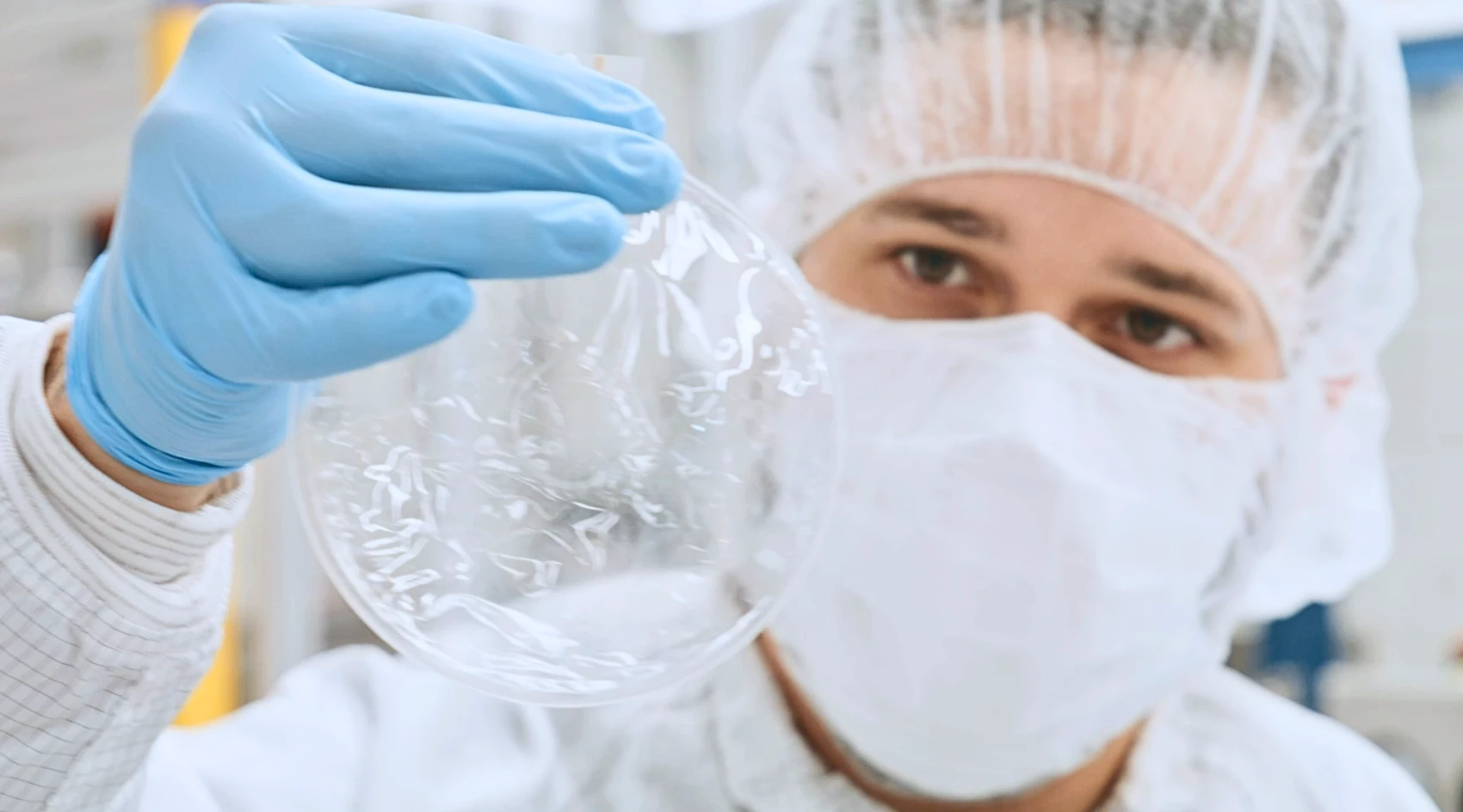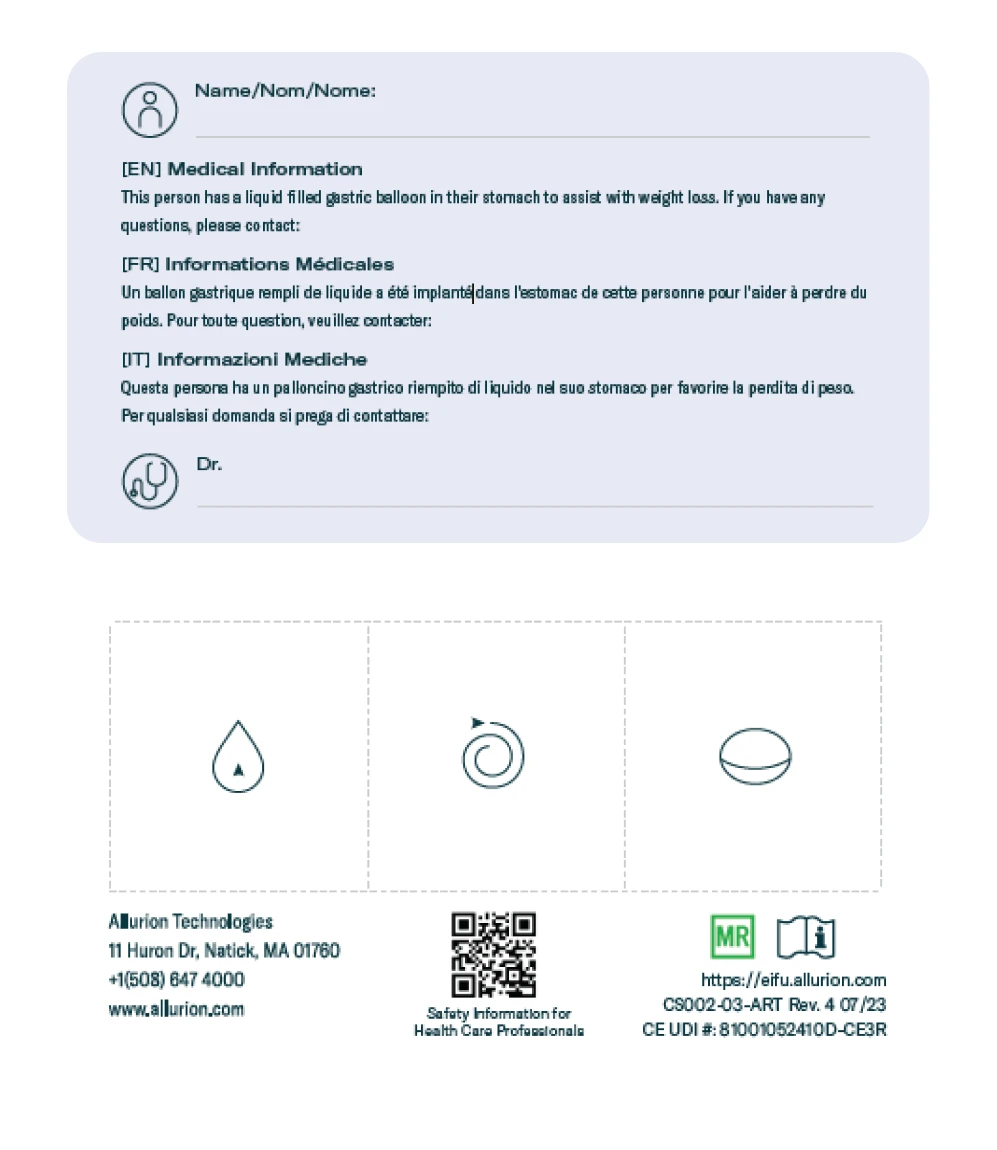
Important Safety Information
The Allurion Balloon is a temporary medical device indicated for weight loss treatment in adults over 18 years old who live with excess weight or obesity with a body mass index (BMI) ≥ 27 kg/m². The Allurion gastric balloon system should be used as part of a monitored behaviour and nutrition modification programme.
This is a regulated health product that has been CE marked since 2015.
If you are interested, discuss it with your doctor to carefully evaluate both the risks and benefits of the treatment and to confirm that this solution is suitable for you.
Eligibility for the placement of an Allurion Balloon will be assessed by a certified doctor after an initial consultation and a careful review of your medical history.
A documented safety profile4
Potential adverse reactions and complications include, but are not limited to the following:
Insufficient or no weight loss | Adverse health consequences resulting from weight loss | Fainting/vasovagal reaction during placement | Nausea and/or vomiting | Chest pain | Heartburn or GERD | Oesophagitis or oesophageal ulcer | Abdominal distension with or without discomfort | Abdominal pain | Gastritis | Gastric dilatation | Gastric or duodenal ulcers | Mallory-Weiss tear | Mucosal laceration | GI bleeding | Difficulty breathing | Dehydration | Diarrhoea | Constipation | Fatigue | Halitosis | Infection | Allergic reaction | Adverse tissue reaction | Pancreatitis | Aspiration, aspiration pneumonia | Esophageal, gastric, intestinal or other organ trauma or perforation | Esophageal, gastric, small bowel, or large bowel obstruction | Need for endoscopic, radiologic, or surgical intervention to repair organ trauma, perforation, obstruction or other complication | Cardiorespiratory sequelae, such as anaphylaxis, myocardial infarction (heart attack), arrhythmia, cardiac arrest, and/or bronchial obstruction and respiratory arrest | Unintended migration of the device | Detachment of balloon during removal, tracheal aspiration, and respiratory arrest | Spontaneous hyperinflation of the balloon. This may be asymptomatic or symptomatic. Symptoms may include abdominal pain, abdominal distention with or without discomfort, difficulty breathing, vomiting, or may cause gastric perforation | Death
In rare cases, the Allurion Balloon may be vomited at the end of the placement period or may require endoscopic or surgical intervention for removal. Endoscopic intervention should be primarily performed in the following cases: balloon intolerance, spontaneous hyperinflation, gastric outlet obstruction
Guidance on when to contact physician for any untoward symptoms
Allurion gastric balloons may cause gastrointestinal complications that may require endoscopic or surgical intervention.
Watch out for certain adverse effects that require immediately consulting the doctor who placed your device, such as:
Persistent nausea
Severe vomiting
Constipation with inability to pass gas
Severe diarrhea
Dehydration
Severe abdominal pain
Severe cramps or discomfort
Abdominal distension
Fever
Gastrointestinal bleeding
Any other unexpected symptom
In case of any emergency, consult a doctor as soon as possible or call 999.
Show your implant card to the healthcare professionals who are treating you.
Guidance regarding the QR code and access to complication management in case the patient is admitted to an emergency facility different from where the balloon was placed
- After placement, your healthcare professional has given you an implant card on which the elements identifying the device, and its manufacturer appear
- This card may also include a QR code referring to the information available to the doctor concerning the management of patients in the event of an adverse reaction.
- If you have lost your implant card and you can't remember the model of balloon that was placed in you, contact the health facility or health professional who performed the implantation.
- In addition, the information on management of complications is accessible on the Allurion website at: allurionsafety.info

Important information to consider before the placement of an Allurion Gastric Balloon
- The Allurion Gastric Balloon is part of a behaviour modification programme that lasts for a minimum of 6 months, to which you must be fully committed. This device is designed to promote weight loss, but only by committing to changing your eating habits and increasing your physical activity will you be able to achieve and maintain a healthy weight in the long term.
- It is important to note that the Allurion Gastric Balloon may cause adverse events, some of which may require removal by endoscopy. Rare cases of spontaneous hyperinflation, small intestine obstruction, stomach dilation, oesophagitis, pancreatitis, or stomach perforation have been reported, requiring surgical intervention.1,4 Please consult the full list of potential complications available above.
- The Allurion Gastric Balloon is not suitable for all patients. Pregnant individuals or those with a history of oesophageal or stomach surgery, among others, are not eligible for the procedure. The complete list of contraindications can be found in the device's instructions for use provided to doctors. Your doctor will review your medical history and conduct a physical examination to confirm your eligibility for the Allurion Programme.
- It is crucial that each doctor and patient carefully assess the risks and benefits of the treatment before using the Allurion device. To learn more about the Allurion Balloon, its effectiveness, and its tolerability, discuss it with your doctor.
- You must be available for follow-up with your doctor throughout the treatment period, especially if you experience the following symptoms, including but not limited to: persistent nausea, vomiting, dehydration, and/or abdominal pain. If you consult other healthcare professionals, inform them that an intragastric balloon is present.
We encourage you to stay close to modern emergency care facilities during the time the balloon is in place, in case serious complications arise.